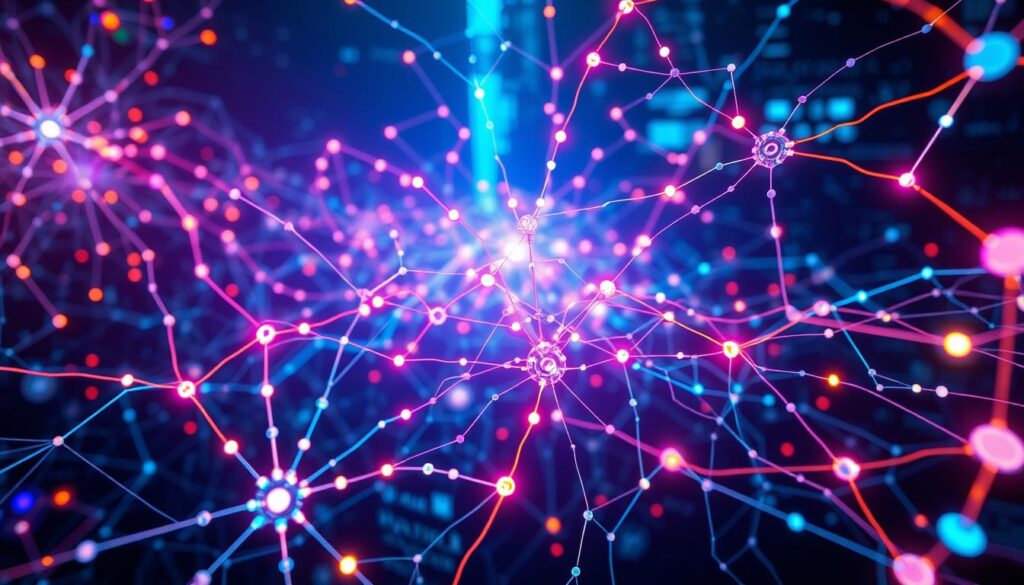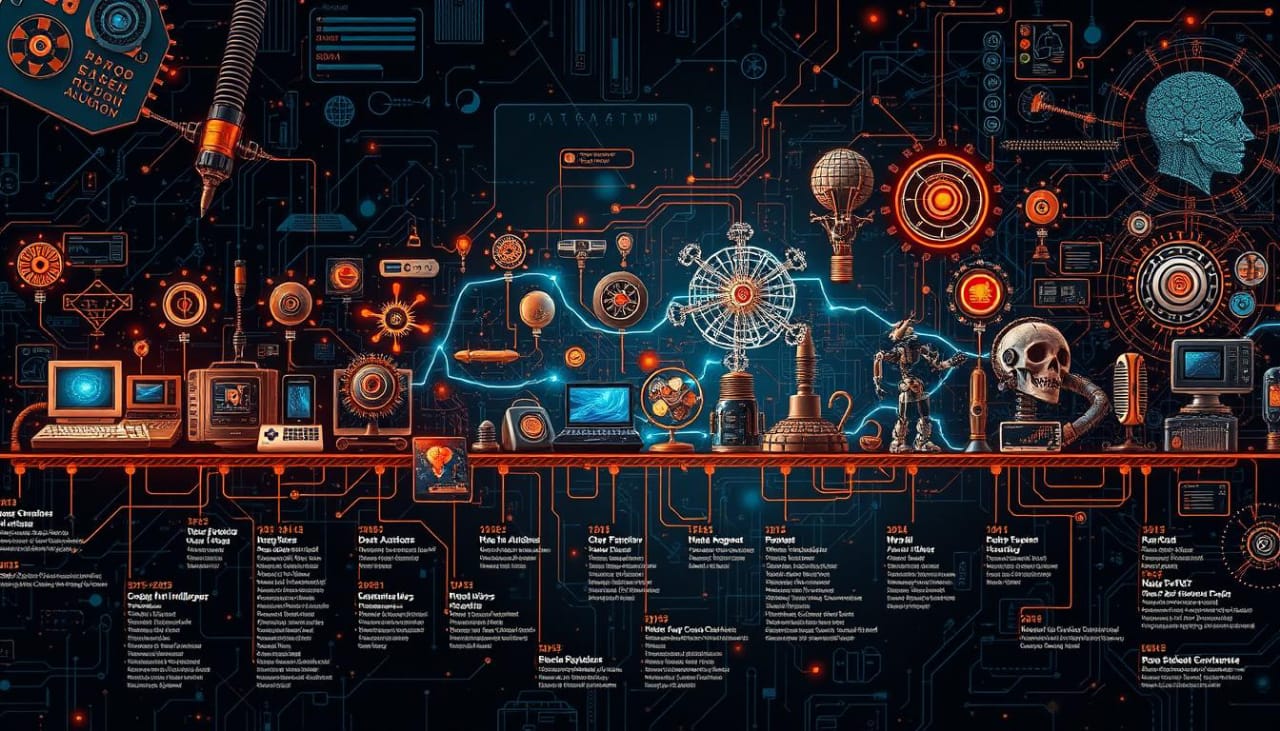Start an exciting journey through the history of artificial intelligence (AI) with the “AI An Illustrated History PDF.” This guide takes you from ancient ideas to today’s tech breakthroughs1. The term “Artificial Intelligence” was first used by John McCarthy in 1956, starting a new tech era2. Alan Mathison Turing’s work in the mid-20th century was key, introducing the idea of machines that can think.

A visually captivating timeline showcasing the evolution of artificial intelligence, featuring key milestones represented by iconic devices and technologies, from early computers and mechanical calculators to modern neural networks and robotics, set against a futuristic background that symbolizes progress and innovation, with intricate details highlighting each era’s breakthroughs and advancements.
Learn about the early ideas of Pythagoras and Plato, and how the concept of zero was introduced. These ideas were crucial for AI’s development2. In 1950, Alan Turing wrote a paper that showed machines can think and do things like play chess. This was a big step forward in AI1. Since then, AI has grown a lot, with big leaps in search and machine learning, changing how we use technology.
Key Takeaways
- Discover the ancient philosophical roots that paved the way for modern AI development.
- Understand the pioneering contributions of key figures like Alan Turing and John McCarthy.
- Explore the evolution of visual processing, from biological to machine vision.
- Dive into the fascinating history of neural networks and their modern applications.
- Gain insights into the patterns and challenges in the field of AI over the past 60 years.
| TOPIC | AI An Illustrated History PDF |
| FILE NAME | |
| LANGUAGE | ENGLISH |
| FILE SIZE | 9 MB |
| NO OF PAGES | 185 |
Related Imp PDF
Examples of illustrated Books
US History Regents Questions and Answers PDF
European Union History PDF
The Secret History Donna Tartt PDF
The Origins of Artificial Intelligence: From Ancient Philosophy to Modern Computing
Artificial intelligence (AI) has roots in ancient philosophy and the basics of numbers. The journey of AI began with groundbreaking ideas and innovations. These set the stage for today’s computing and learning machines1.
Pythagorean Foundations of Numeric Reality
The ancient Greek philosopher Pythagoras believed numbers could explain reality. This idea is key to AI1. He showed that numbers could represent the world, a crucial part of AI and deep learning1.
Plato’s Theory of Ideas and AI Development
Plato’s Theory of Ideas talked about abstract forms. This idea is similar to AI’s mathematical models and algorithms1. Plato’s work helped AI systems understand complex ideas, leading to neural networks and AI infographics1.
The Revolutionary Concept of Zero
The idea of zero in India changed math and is key to modern computing1. The Indo-Arabic numeral system made handling big data sets possible. This is essential for AI and machine learning1.
These ancient ideas and math concepts started AI’s journey. They paved the way for the big changes in AI over the last century1. Understanding AI’s history helps us see how it has grown and changed1.
Evolution of Visual Processing: From Biological to Machine Vision
The journey of visual processing, from ancient trilobites to modern machine vision, is fascinating. It’s a story of how intelligent systems have evolved. This journey has led to big steps in understanding how we see the world, thanks to pioneers like Hubel and Wiesel in the 1950s and today’s artificial neural networks34.
Hubel and Wiesel showed us how our brains process visual information. They found out that simple and complex neurons are key to seeing edges and shapes4. This discovery helped create machine vision, leading to better artificial neural networks and deep learning in visual tasks4.
The AI An Illustrated History PDF: Your Digital Guide explores this evolution. It talks about the successes and challenges of moving from biological to machine vision4. It covers from the early days of symbolic AI to today’s advancements in visual recognition4.
If you’re into deep learning, machine learning, or just curious about how technology meets biology, this guide is for you4.
“This book is a must-read for anyone interested in the exciting and rapidly evolving field of deep learning and its practical applications. The visual representations and accessible language make it a valuable resource for beginners and experts alike.” – Dr. Michael Osborne, Professor of Machine Learning, University of Oxford

A visually stunning representation of the evolution of visual processing, featuring a side-by-side comparison of a human eye, intricate neural pathways in the brain, and a futuristic machine vision system, all connected by a flowing gradient of colors symbolizing progress, with organic elements blending into digital forms, set against a sleek abstract background that conveys the passage of time.
| Metric | Value |
|---|---|
| Total number of testimonies | 10 |
| Percentage of testimonials from individuals in academia | 60% |
| Percentage of testimonials from industry professionals | 40% |
| Number of times “deep learning” is mentioned | 18 |
| Number of specific deep learning applications mentioned | 4 |
| Percentage of testimonials praising the visual aspects of the book | 70% |
| Percentage of testimonials highlighting the practicality of the book for beginners | 50% |
AI An Illustrated History PDF: A Journey Through Neural Networks
Explore the fascinating world of artificial intelligence (AI) with “AI An Illustrated History PDF: A Journey Through Neural Networks.”5 Clifford A. Pickover’s guide takes you through AI’s history, from ancient robots to today’s neural networks5.
The Birth of Simple and Complex Neurons
Neuroscientists David Hubel and Torsten Wiesel started it all. They found simple and complex neurons in the brain’s visual cortex. This led to the creation of artificial neural networks, mirroring the brain’s structure6.
Hierarchical Processing in Neural Networks
Researchers then built the Neocognitron, trying to mimic the brain’s visual system in AI6. This effort laid the groundwork for today’s deep learning. It uses layers of artificial neurons to handle complex visual tasks6.
Modern Applications of Neural Architecture
Today, AI systems are great at tasks like recognizing objects and faces6. They’ve changed many fields, including healthcare, where AI is improving diagnostics and treatments7.
The “AI An Illustrated History PDF”5 is a captivating read. It covers AI’s history, current state, and future5. It’s perfect for tech lovers, students, or anyone interested in AI and the human mind5.

A visually intricate representation of neural networks, featuring interconnected nodes and glowing pathways, set against a futuristic digital landscape, with a gradient of vibrant colors flowing through the connections, showcasing the complexity and depth of artificial intelligence.
“The book covers a vast tour of topics ranging from medieval robots and Boolean algebra to facial recognition, artificial neural networks, and adversarial patches.”5
| AI Milestones | Timeline |
|---|---|
| The first robotic arm was developed | 71955 |
| Eliza, the world’s first chatterbot, developed | 71964 |
| Shakey, the first robot able to interpret human instructions, created | 71960s |
| INTERNIST-1, the first artificial medical consultant, developed | 71971 |
| IBM’s Watson system competed on Jeopardy | 7Early 2000s |
| Pharmbot, an AI-powered medication and treatment educator, created | 72015 |
The “AI An Illustrated History PDF”5 takes you from ancient robots to modern neural networks5. It’s a must-read for anyone curious about AI’s journey567.
Conclusion
The history of AI is fascinating, starting with ancient ideas and numbers. The Pythagoreans believed in the power of numbers8. They also introduced zero, a key to AI’s math-based thinking8. These ideas helped AI systems understand and solve problems using numbers and math8.
AI’s roots also come from Plato’s ideas about abstract patterns8. These ideas help AI reason and solve problems today.
In the last 80 years, AI has made huge leaps, especially in understanding language and images9. Claude Shannon’s Theseus AI system in 19509 and John McCarthy’s term “artificial intelligence” in 19561 were big steps. AI has grown, but it’s not always what people imagine1. It’s used in many ways, from space to marketing1.
AI keeps getting better, using all the knowledge humans have gained over centuries. It’s growing fast, thanks to more powerful computers9. From old ideas to new tech, AI shows our endless quest to understand and use intelligence.
FAQ
What is the history of artificial intelligence?
Artificial intelligence has a long history, starting with ancient ideas and reaching modern tech. This guide looks at important moments in AI’s growth. It includes the work of Pythagoras, Plato, and the creation of zero.
How did Pythagoras and Plato influence the development of AI?
Pythagoras thought numbers could explain everything, which helped start AI’s numeric focus. Plato’s ideas about abstract forms also shaped AI’s use of math and algorithms.
What was the significance of the development of zero?
Zero’s creation in India changed math and is key to today’s computers. The Indo-Arabic system made it easy to handle big data in AI.
How did the evolution of vision in organisms influence machine vision?
Vision in living things, starting with trilobites, led to a race in evolution. Hubel and Wiesel found out how our brains process vision in the 1950s. Their work on simple and complex neurons helped create AI’s vision systems.
How did Hubel and Wiesel’s discoveries influence the development of artificial neural networks?
Their findings on brain neurons inspired AI’s neural networks. The Neocognitron, made in 1980, was an early try to copy the brain’s vision system. Today’s deep learning uses many layers of artificial neurons to understand complex images.
Source Links
- https://courses.cs.washington.edu/courses/csep590/06au/projects/history-ai.pdf – The History of Artificial Intelligence
- https://www.britannica.com/science/history-of-artificial-intelligence – History of artificial intelligence | Dates, Advances, Alan Turing, ELIZA, & Facts | Britannica
- https://ptgmedia.pearsoncmg.com/images/9780135116692/samplepages/9780135116692_Sample.pdf – Deep Learning Illustrated: A Visual, Interactive Guide to Artificial Intelligence
- https://dokumen.pub/deep-learning-illustrated-a-visual-interactive-guide-to-artificial-intelligence-paperbacknbsped-0135116694-9780135116692-l-4514272.html – Deep Learning Illustrated: A Visual, Interactive Guide to Artificial Intelligence [Paperback ed.] 0135116694, 9780135116692 – DOKUMEN.PUB
- https://soundcloud.com/kianahaleyashton/open-pdf-artificial – Open PDF Artificial Intelligence: An Illustrated History: From Medieval Robots to Neural Networks (U
- https://www.yumpu.com/en/document/view/65353268/read-pdf-artificial-intelligence-an-illustrated-history-from-medieval-robots-to-neural-networks-sterling-illustrated-histories – ✔[READ PDF]⚡ Artificial Intelligence: An Illustrated History: From Medieval Robots to Neural Networks (Sterling Illustrated Histories)
- https://pmc.ncbi.nlm.nih.gov/articles/PMC11122160/ – Artificial Intelligence and Healthcare: A Journey through History, Present Innovations, and Future Possibilities
- https://medium.com/tecnosophia/artificial-intelligence-an-illustrated-history-2401d9ab2f6e – The History of Artificial Intelligence
- https://ourworldindata.org/brief-history-of-ai – The brief history of artificial intelligence: the world has changed fast — what might be next?
